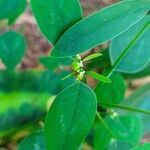Herbs, usually annual, rarely perennial, with slender, rarely tuberous, taproot. Stems erect or ascending, branched, 30–80(–110) cm, strigillose or glabrescent, sharply angled. Leaves usually alternate, sometimes some opposite; stipules usually 0.2–0.5 mm, rarely rudimentary; petiole 0.4–5.9 mm, strigillose; blade ovate, elliptic, linear-elliptic, or oblong, 10–83 × 3–39 mm, base attenuate, rounded, or cuneate, margins entire, apex acute or obtuse, surfaces strigillose; venation occasionally obscure on narrow leaves, midvein conspicuous. Cyathia in usually terminal, rarely axillary, dichasia, distal dichasial bracts often white; peduncle 0.4–4.5 mm (to 15 mm at first node of inflorescence), glabrous. Involucre campanulate or obconic, 1–1.8 × 0.8–1.7 mm, glabrous or strigillose toward rim; glands (1–)2–4, yellow to greenish, elliptic or oblong, 0.1–0.3 × 0.2–0.4 mm; appendages white to tinged purple, ovate and often hoodlike or forming narrow rim around distal margin of gland, 0.3–1.6 × 0.4–0.9 mm, entire. Staminate flowers 30–40. Pistillate flowers: ovary glabrous; styles 0.7–1 mm, 2-fid from 1/2 to nearly entire length. Capsules ovoid-oblate, 2.5–3 × 3–3.5 mm, glabrous; columella 1.6–1.9 mm. Seeds gray, brown, or nearly black, ovoid, circular or weakly angled in cross section, 1.5–1.7 × 1.3–1.5 mm, coarsely tuberculate with longitudinal rows of shallow pits; caruncle absent or punctiform, 0.1–0.2 mm.
More
Herb, stems terete, not articulate, branching from base, sprawling to 1.5 m long. Leaves alternate, becoming opposite above; stipules obsolete; petiole to 2 cm long; blade oblong-elliptic to sublinear or rarely ovate, 2.5-4(-8) X 0.5-1.5(-5) cm, green, short pubescent or glabrous, the base acute to obtuse, the margin entire, the apex acute. Cyathia terminal on dichotomizing upper branches, funnelform, ca 1 mm diam; glands 2-4, minute, exappendiculate (extra-Panamanian specimens often with large white appendages). Capsule broadly ovoid, ca 3.5 mm diam, glabrous; seed ovoid, 1.5 mm long, angular, deeply punctate with pits in regular longitudinal rows, ecarunculate.
A herb. The stems are 1.5 m long.

